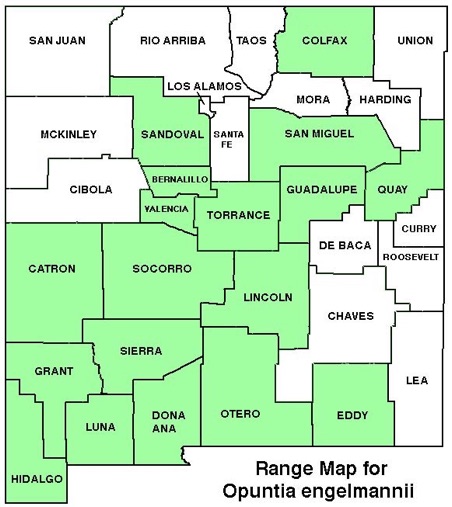WILDFLOWERS OF NEW MEXICO

This large-scale, shrubby cactus with thorny pads often forms dense, spreading thickets 3–9-feet high and wide. With time, stems can develop short trunks. Note the large, oval pads, reaching 15-inches long and wide (40 cm), have 1–6 flattened chalky-white or yellowish spines that extend downward. Areoles are evenly distributed over most of the pad surface, or sometime pads can be almost spineless.
SPINES: Flat, yellow-green pads, circular to egg shaped, 8–14-inches long, are crosshatched with rows of widely spaced areoles with a combination of bristly tufts barbed glochids and 1–6 (often 3) rigid, straight spines. Typically, the spines extend downward spreading like a bird's foot. Spines, 1/2–2-inches long, have a flattened base. The widespread var. engelmannii has white spines and var. lindheimeri, in se NM, has yellowish spines. On all prickly pears, beware the vicious, brown glochid bristles that surround the areoles on the pads and fruit.
FLOWER: March–July. Showy flowers, 2–4-inches wide, solid yellow to buff, never red variegated. The filaments, anther, and style are creamy white, the stigma lobes yellowish-green. Juicy, barrel-shaped fruit mature red to purple, 1–3 1/2-inches long, areoles with glochids but not spines, edible.
HABITAT: Sandy, gravelly soils; desert grasslands and scrub, pinyon-juniper-oak woodlands.
ELEVATION: 4,000–8,000 feet.
RANGE: AZ, CA, NM, NV, UT, TX.
SIMILAR SPECIES: Cowtongue Prickly Pear, O. engelmanii var. linguiformis, a variety of Engelmann’s Prickly Pear with greatly elongated pads, is popular in landscapes. The petals of the showy yellow flowers of the widespread Brown-spined Prickly Pear, O. phaeacantha, usually have a reddish base. Pancake Prickly Pear, O. chlorotica, in sw NM, develops a noticeable trunk and has yellow to black, downward-pointing thorns.
NOTES: The pulp and juice of the fruit have many culinary uses, including jelly and a punch drink. Pick the fruit when it loses its dull, chalky look and becomes bright purple. Preparation requires care when removing the glochid spines.
NM COUNTIES: North-central to se and sw NM in low- to mid-elevation, dry habitats: Bernalillo, Catron, Colfax, Dona Ana, Eddy, Grant, Guadalupe, Hidalgo, Lincoln, Luna, Otero, Quay, San Miguel, Sandoval, Sierra, Socorro, Torrance.









ENGELMANN’S PRICKLY PEAR CACTUS
OPUNTIA ENGELMANNII
Cactus Family, Cactaceae
Perennial, shrubby cactus









THE CONTENTS OF THIS WEBSITE ARE COPYRIGHTED AND CANNOT BE USED
WITHOUT PERMISSION OF GEORGE OXFORD MILLER


























The widespread Opuntia engelmannii var. engelmanii has white spines (left), and var. lindheimeri in se NM has yellowish spines (right).




















The succulent fruit, or tunas, similar to watermelon in taste, make flavorful jellies and refreshing drinks–but beware the hair-like, barbed glochid spines (arrow). It’s ripe when it gets a purple sheen.



























EMAIL ME







